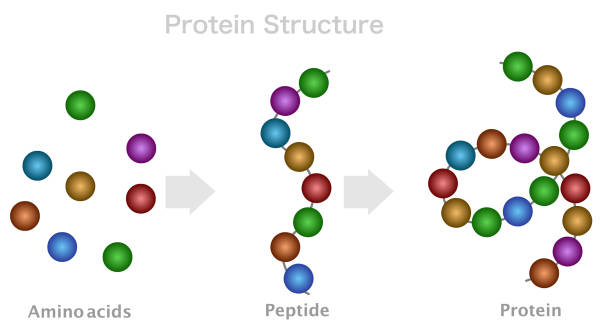Chapter 7 – Nutrition
 Proteins
Proteins
Protein is another major macronutrient that, like carbohydrates, consists of small repeating units. But instead of sugars, proteins are made up of amino acids. Amino Acids are the building blocks of protein and are needed to make the protein structures that build and maintain the tissues in the body.
There are many different amino acids; they all have similar structures but are differentiated by their side chains. All proteins, no matter what food they come from, are made up of amino acids.
Functions of Protein in the Body
Proteins are molecules that support everything your body does. Proteins provide the basic building blocks for body structures as well functional roles in physiological functions: .
- Protein synthesis: Help cells in your body “read” genes and use that information to build new cells and molecules, including new proteins
- Provide structure to cells and tissues throughout your body
- Attach to invaders, like bacteria and viruses, to clear them from your body
- Protein enzymes: break down nutrients in the foods you eat
- Send chemical signals and carry information from cell to cell
- Speed up (catalyze) chemical reactions within cells, which helps create the energy your body needs to function
- Serve as gates in a cell’s outer membrane that allow substances to pass in or out of the cell
- Transport small molecules throughout your body (for example, a protein in your blood called hemoglobin carries oxygen to body’s tissues)
Types of Proteins
Proteins can be classified as either complete or incomplete. Complete proteins provide adequate amounts of all nine essential amino acids. Animal proteins, such as meat, fish, milk, and eggs, are good examples of complete proteins. Incomplete proteins do not contain adequate amounts of one or more of the essential amino acids. For example, if a protein does not provide enough of the essential amino acid leucine it would be considered incomplete. Leucine would be referred to as the limiting amino acid because there is not enough of it for the protein to be complete. Most plant foods are incomplete proteins, with a few exceptions, such as soy.
Examples of Complete Proteins:
- Fish
- Poultry (chicken, duck, or turkey)
- Eggs
- Dairy products (milk, yogurt, or cheese, for example)
- Beef or pork
- Soy products, such as tofu and edamame
- Quinoa
- Buckwheat
- Hempseed
Examples of Incomplete Proteins:
- Nuts and seeds
- Whole grains (like brown rice or whole-wheat bread)
- Vegetables
- Legumes in the form of lentils, peas, and beans.
Complimentary Proteins
Certain dietary options (such as vegetarian or vegan) may limit intake of many complete protein options. However, there is a simple solution to ensure complete proteins are available for use in the body. Combining two or more foods with incomplete proteins, to form complementary proteins, can provide adequate amounts of all the essential amino acids. Complementary proteins do not need to be eaten together, so long as the day’s meals supply them all. Here are some common meal items that naturally complement each others’ proteins:
- Beans and rice or tortillas
- Peanut butter sandwich
- Tofu with rice (or any grain)
- Hummus with pita bread
- Grilled cheese sandwich (on whole grain bread)
- Yogurt with nuts
- Noodle stir-fry with peanut or sesame seed sauce
- Lentil soup or dairy-based soup with bread
- Whole grain cereal with milk
- Tacos filled with beans or lentils
- Quinoa salad with black beans and feta
 Recommended Intake
Recommended Intake
The Recommended Dietary Allowance (RDA) for protein is a modest 0.8 grams of protein per kilogram of body weight, or 0.36 grams per pound. To determine your daily protein intake, you can multiply your weight in pounds by 0.36.
So if you aim to take in 2,000 calories a day, 600-700 calories should be from proteins. In general, protein gives you about 4 calories a gram, so that’s between 50-175 grams of protein a day.

